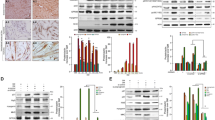Abstract
Insulin-like growth factor II (IGF-II) can stimulate myogenesis and is critically involved in skeletal muscle differentiation. The presence of negative regulators of this process, however, is not well explored. Here, we showed that in myoblast cells, IGF-II negatively regulated peroxisome proliferator-activated receptor-γ coactivator-1α (PGC-1α) mRNA expression, while constitutive expression of PGC-1α induced myoblast differentiation. These results suggest that the negative regulation of PGC-1α by IGF-II may act as a negative feedback mechanism in IGF-II-induced myogenic differentiation. Reporter assays demonstrated that IGF-II suppresses the basal PGC-1α promoter activity. Blocking the IGF-II signaling pathway increased the endogenous PGC-1α levels. In addition, pharmacological inhibition of PI3 kinase activity prevented the downregulation of PGC-1α but the activation of mTOR was not required for this process. Importantly, further analysis showed that forkhead transcription factor FoxO1 contributes to mediating the effects of IGF-II on PGC-1 promoter activity. These findings indicate that IGF-II reduces PGC-1α expression in skeletal muscle cells through a mechanism involving PI3K–Akt–FoxO1 but not p38 MAPK or Erk1/2 MAPK pathways.





Similar content being viewed by others
References
Buckingham M (2001) Skeletal muscle formation in vertebrates. Curr Opin Genet Dev 11:440–448
Zanou N, Gailly P (2013) Skeletal muscle hypertrophy and regeneration: interplay between the myogenic regulatory factors (MRFs) and insulin-like growth factors (IGFs) pathways. Cell Mol Life Sci 70:4117–4130
Duan C, Ren H, Gao S (2010) Insulin-like growth factors (IGFs), IGF receptors, and IGF-binding proteins: roles in skeletal muscle growth and differentiation. Gen Comp Endocrinol 167:344–351
Bois PR, Grosveld GC (2003) FKHR (FOXO1a) is required for myotube fusion of primary mouse myoblasts. EMBO J 22:1147–1157
Hribal ML, Nakae J, Kitamura T, Shutter JR, Accili D (2003) Regulation of insulin-like growth factor-dependent myoblast differentiation by Foxo forkhead transcription factors. J Cell Biol 162:535–541
Erbay E, Park IH, Nuzzi PD, Schoenherr CJ, Chen J (2003) IGF-II transcription in skeletal myogenesis is controlled by mTOR and nutrients. J Cell Biol 163:931–936
Norrbom J, Sundberg CJ, Ameln H, Kraus WE, Jansson E, et al (2004) PGC-1α mRNA expression is influenced by metabolic perturbation in exercising human skeletal muscle. J Appl Physiol (1985) 96: 189–194.
Arany Z, Foo SY, Ma Y, Ruas JL, Bommi-Reddy A et al (2008) HIF-independent regulation of VEGF and angiogenesis by the transcriptional coactivator PGC-1α. Nature 451:1008–1012
Zechner C, Lai L, Zechner JF, Geng T, Yan Z et al (2010) Total skeletal muscle PGC-1 deficiency uncouples mitochondrial derangements from fiber type determination and insulin sensitivity. Cell Metab 12:633–642
Ling C, Poulsen P, Carlsson E, Ridderstrale M, Almgren P et al (2004) Multiple environmental and genetic factors influence skeletal muscle PGC-1α and PGC-1beta gene expression in twins. J Clin Invest 114:1518–1526
Jiao S, Ren H, Li Y, Zhou J, Duan C et al (2012) Differential regulation of IGF-I and IGF-II gene expression in skeletal muscle cells. Mol Cell Biochem 373:107–113
Attias-Geva Z, Bentov I, Ludwig DL, Fishman A, Bruchim I et al (2011) Insulin-like growth factor-I receptor (IGF-IR) targeting with monoclonal antibody cixutumumab (IMC-A12) inhibits IGF-I action in endometrial cancer cells. Eur J Cancer 47:1717–1726
Ren H, Yin P, Duan C (2008) IGFBP-5 regulates muscle cell differentiation by binding to IGF-II and switching on the IGF-II auto-regulation loop. J Cell Biol 182:979–991
Herzig S, Long F, Jhala US, Hedrick S, Quinn R et al (2001) CREB regulates hepatic gluconeogenesis through the coactivator PGC-1. Nature 413:179–183
Remels AH, Langen RC, Schrauwen P, Schaart G, Schols AM, et al. (2009) Regulation of mitochondrial biogenesis during myogenesis. Mol Cell Endocrinol 315: 113–120.
Daitoku H, Yamagata K, Matsuzaki H, Hatta M, Fukamizu A (2003) Regulation of PGC-1 promoter activity by protein kinase B and the forkhead transcription factor FKHR. Diabetes 52:642–649
Cook SA, Matsui T, Li L, Rosenzweig A (2002) Transcriptional effects of chronic Akt activation in the heart. J Biol Chem 277:22528–22533
Rommel C, Bodine SC, Clarke BA, Rossman R, Nunez L et al (2001) Mediation of IGF-1-induced skeletal myotube hypertrophy by PI(3)K/Akt/mTOR and PI(3)K/Akt/GSK3 pathways. Nat Cell Biol 3:1009–1013
Willett M, Cowan JL, Vlasak M, Coldwell MJ, Morley SJ (2009) Inhibition of mammalian target of rapamycin (mTOR) signalling in C2C12 myoblasts prevents myogenic differentiation without affecting the hyperphosphorylation of 4E-BP1. Cell Signal 21:1504–1512
Handschin C, Kobayashi YM, Chin S, Seale P, Campbell KP et al (2007) PGC-1α regulates the neuromuscular junction program and ameliorates Duchenne muscular dystrophy. Genes Dev 21:770–783
Sandri M, Lin J, Handschin C, Yang W, Arany ZP et al (2006) PGC-1α protects skeletal muscle from atrophy by suppressing FoxO3 action and atrophy-specific gene transcription. Proc Natl Acad Sci USA 103:16260–16265
Leone TC, Lehman JJ, Finck BN, Schaeffer PJ, Wende AR et al (2005) PGC-1α deficiency causes multi-system energy metabolic derangements: muscle dysfunction, abnormal weight control and hepatic steatosis. PLoS Biol 3:e101
Lin Y, Zhao Y, Li R et al (2014) PGC-1α is associated with C2C12 Myoblast differentiation. Cent EurJ Biol 9:1030–1036
Williamson DL, Butler DC, Alway SE (2009) AMPK inhibits myoblast differentiation through a PGC-1α-dependent mechanism. Am J Physiol Endocrinol Metab 297:E304–E314
Acknowledgements
We thank Dr. Cunming Duan from University of Michigan, Ann Arbor, for providing reagents and discussion. We are grateful to Ms. Chunyang Zhang, Indiana University, for reading and commenting on an early version of this manuscript. This work was supported by Natural Scientific Foundation of China (31572261), Natural Science Foundation of Shandong Province, China (ZR2014CM007), and NSFC-Shandong Joint Fund (U1406402).
Author information
Authors and Affiliations
Corresponding author
Electronic supplementary material
Below is the link to the electronic supplementary material.
Rights and permissions
About this article
Cite this article
Mu, X., Qi, W., Liu, Y. et al. IGF-II-mediated downregulation of peroxisome proliferator-activated receptor-γ coactivator-1α in myoblast cells involves PI3K/Akt/FoxO1 signaling pathway. Mol Cell Biochem 432, 199–208 (2017). https://doi.org/10.1007/s11010-017-3010-4
Received:
Accepted:
Published:
Issue Date:
DOI: https://doi.org/10.1007/s11010-017-3010-4




